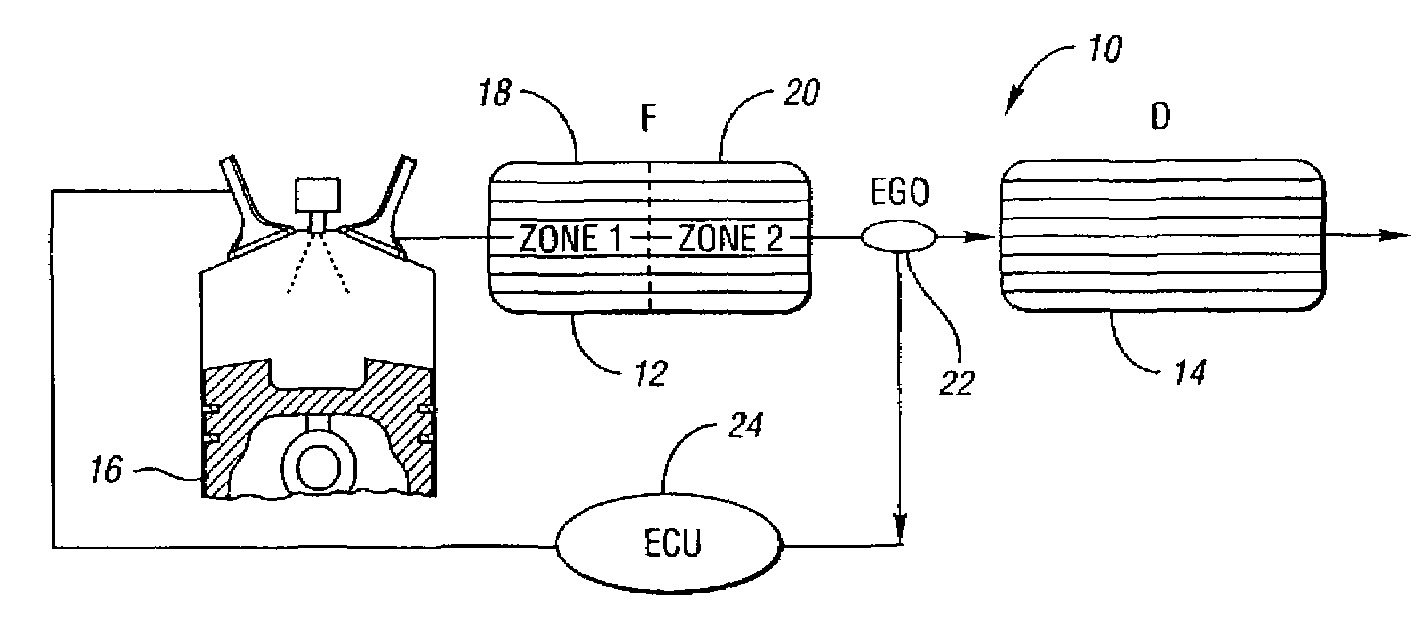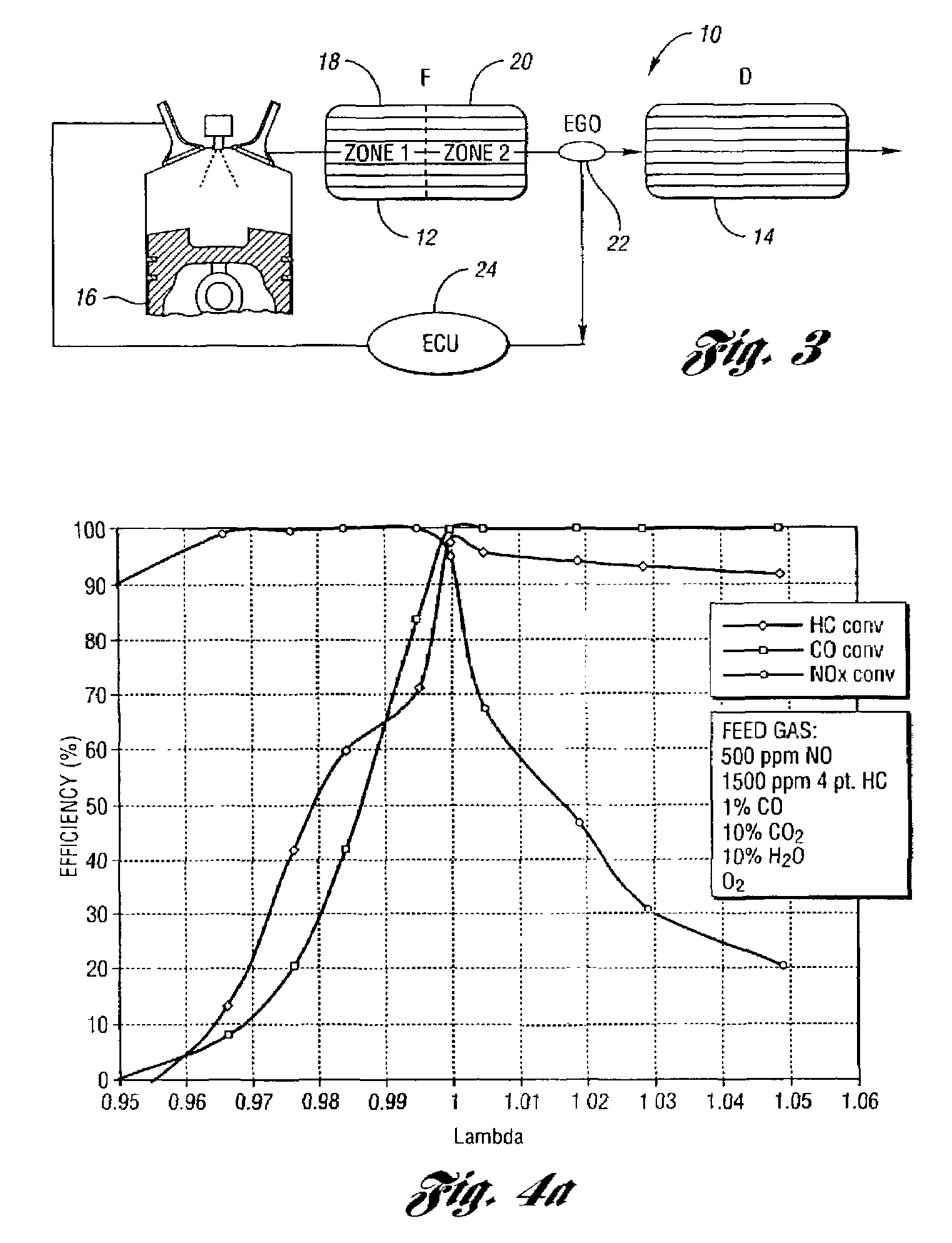Catalyst system for lean burn engines
a technology of catalyst system and burn engine, which is applied in the direction of physical/chemical process catalyst, metal/metal-oxide/metal-hydroxide catalyst, separation process, etc., can solve the problems of increasing the difficulty of treating some polluting gases, developing a lean bias, and high cost of catalyst manufacture, so as to eliminate nox release and increase thermal stability and light-off
- Summary
- Abstract
- Description
- Claims
- Application Information
AI Technical Summary
Benefits of technology
Problems solved by technology
Method used
Image
Examples
example 1
[0054]Fumed alumina Al2O3 (15 g, Degussa), Ba(NO3)2 (7.42 g), KNO3 (0.3 g), La (NO3)3.6H2O(20.3 g), and H2PtCl6.6H2O (1.48 g) are each added to 500 ml deionized water, heated to 60° C., and then mixed as solution 1 with the final desired ratios. A rhodium solution containing 0.10 g Rh(NO3)4 is deposited onto 2.6 g ZrO2, dried at 80 E C for eight hours and then calcined at 600° C. for six hours. The resulting powder is crushed and added to solution 1. Meanwhile, fumed alumina Al2O3 (15 g, Degussa), Ba(NO3)2 (14.84 g), and Rh(NO3)4 (0.1 g), and H2PtCl6.6H2O (0.23 g) are each added to 500 ml deionized water, heated to 60° C., and then mixed as solution 2 with the final desired ratios. The top half of a core of 400 cell per square inch cordierite (2 inch in diameter and 3.25 inch in length, zone 1) was dipped into solution 1, and then dried at 80° C. overnight. This process was repeated until the desired amount of mixed compound was coated on the core. The bottom half of the core (zone ...
example 2
[0055]This is a comparative example of a conventional lean NOx trap. Fumed alumina (50.0 g, Degussa), and Ba(NO3)2 (17.13 g) are dissolved in 500 ml deionized water. This mixture is stirred on a hot plate for 1 hour, and then dried at 80° C. overnight, and then calcined at 600° C. for 6 hours. The calcined powder is ground with 2.5 g Ce / Zr mixed oxide (W.R. Grace) for 48 hr in 100 ml deionized water. Then it is dried at 80° C. overnight, and calcined at 600° C. for 6 hours. This powder is then mixed with H2PtCl6.6H2O in 2.65 g deionized water, ground for 24 hour, then dried at 80° C. and calcined at 600° C. for 6 hr.
example 3
[0056]This example shows the test procedures and conditions. The steady state lean NOx trapping efficiency was measured in a flow reactor as an average efficiency during a 1 minute lean period under different temperatures. The feedgas cycled with 60 seconds lean and 5 seconds rich at a constant space velocity of 30,000 hour−1. The flow rates were strictly controlled by mass flow controllers. The gas concentrations were measured by a V&F mass spectrometer. The feedgas composition was:
[0057]
GasesConcentration (lean)Concentration (rich)NO 500 ppm 500 ppmHC1500 ppm1500 ppmCO0 4%H201.33%O2 6%0CO210% 10%H2O10% 10%N2balancebalance
[0058]The lambda sweep tests were also conducted in a flow reactor at 400° C. with a gas space velocity of 30,000 hour−1. Here the feedgas composition remains constant except the oxygen concentration varies to achieve the desired lambda value. The feedgas contains 2000 ppm HC, 500 ppm NO, 1% CO, 0.33% H2, 10% CO2, 10% H2O, and N2 balance.
[0059]Catalyst aging is...
PUM
| Property | Measurement | Unit |
|---|---|---|
| exothermic temperature | aaaaa | aaaaa |
| operating temperatures | aaaaa | aaaaa |
| temperature | aaaaa | aaaaa |
Abstract
Description
Claims
Application Information
 Login to View More
Login to View More - R&D
- Intellectual Property
- Life Sciences
- Materials
- Tech Scout
- Unparalleled Data Quality
- Higher Quality Content
- 60% Fewer Hallucinations
Browse by: Latest US Patents, China's latest patents, Technical Efficacy Thesaurus, Application Domain, Technology Topic, Popular Technical Reports.
© 2025 PatSnap. All rights reserved.Legal|Privacy policy|Modern Slavery Act Transparency Statement|Sitemap|About US| Contact US: help@patsnap.com



